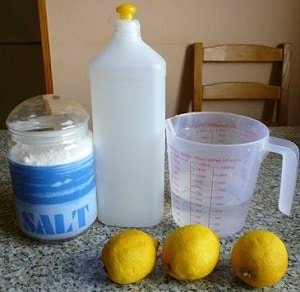Good ingredients for making dishwashing liquid include surfactants, water softeners, pH adjusters, and fragrances. Essential components also feature preservatives and coloring agents.
Creating an effective dishwashing liquid is both science and art. The goal is to combine substances that effectively break down and remove grease, food particles, and stains from dishes while being gentle on the skin and environmentally friendly. Surfactants, such as sodium lauryl sulfate, are the backbone of any dishwashing formula, cutting through grease and ensuring that dishes come out sparkling clean.
Water softeners, like sodium carbonate, work against minerals in hard water that can impede cleaning efficiency. PH adjusters, often citric acid or sodium hydroxide, maintain a balanced acidity that optimizes cleaning power and prevents damage to dishes and dishwasher components.
Scents from natural oils can provide a pleasant sensory experience. Meanwhile, preservatives keep the liquid shelf-stable, and dyes are sometimes added for aesthetic appeal. Crafting the perfect blend requires a balance of these ingredients for a dishwashing liquid that is both potent and user-friendly.
Table of Contents
Introduction To Homemade Dishwashing Liquids
Introduction to Homemade Dishwashing Liquids explores the trend of creating custom cleaning solutions. Many households opt for homemade alternatives for reasons like cost-efficiency and environmentally friendly benefits. We dive into what makes these DIY solutions effective and safe.
Benefits Of Crafting Your Own
- Cost Savings: Homemade dishwashing liquids can be less expensive than store-bought ones.
- Customization: Tailor the ingredients to suit your needs and preferences.
- Eco-friendly: Reduce the environmental impact by using biodegradable components.
- Healthier Choice: Avoid harsh chemicals found in some commercial brands.
Essential Components
Gather these key ingredients to make your dishwashing liquid:
Ingredient |
Function |
|---|---|
Distilled water |
Acts as a base for the solution. |
Liquid castile soap |
Cleans and cuts grease. |
Baking soda |
Removes tough stains and odors. |
Essential oils |
Provides a pleasant scent and antibacterial properties. |
Vinegar |
Works as a natural disinfectant. |
Salt |
Serves as a scrubbing agent. |

Credit: www.youtube.com
Primary Cleaning Agents
Primary Cleaning Agents are the muscles behind dishwashing liquids. They tackle grease, grime, and food particles, ensuring dishes come out sparkling clean. These agents are crucial for an effective wash. Let’s explore the roles of surfactants, a key ingredient in these cleaning warriors.
Roles Of Surfactants
Surfactants are the heart of any dishwashing liquid. They are special molecules that help water mix with oil and dirt, so they can be washed away. Here are their main functions:
- Wet surfaces: Surfactants reduce water’s surface tension, allowing it to spread and wet surfaces quickly.
- Lift soil: They surround and lift away dirt from the surface of dishes.
- Emulsify grease: Surfactants break down and hold grease in the water so it can be rinsed away.
- Suspend soil: They keep dirt and debris suspended in the water to prevent re-deposition on dishes.
Choosing The Right Surfactants
Selecting the right surfactants ensures your dishwashing liquid is tough on stains but gentle on hands. Consider these factors:
Surfactant Type |
Cleaning Power |
Skin Mildness |
|---|---|---|
Anionic |
High |
Varies |
Nonionic |
Medium |
High |
Amphoteric |
Low |
Very High |
For an effective blend, look for dishwashing formulas that combine these surfactants. This approach balances cleaning power with gentleness for a wide range of uses.
Suds And Foam Factors
Creating the perfect dishwashing liquid involves understanding the ‘Suds and Foam Factors.’ Suds and foam play a crucial role in the cleaning process. They are not just for show. The lather helps lift and trap dirt, making it easier to rinse away. This section will dive into what makes a dishwashing liquid effective and enjoyable to use.
Importance Of Lather
Foam and suds signal cleaning action. A rich lather ensures that dishes are not just wet but properly scrubbed. It helps in breaking down grease and food residues. The right amount of foam can make dishwashing more efficient. It also indicates that the dishwashing liquid is working as it should. But what makes that satisfying lather?
Ingredients That Boost Foam
Certain ingredients can increase foam production. These are called surfactants and foaming agents. Surfactants lower the surface tension of water. This action allows bubbles to form. Let’s look at some common foam-enhancing ingredients:
- Sodium Laureth Sulfate (SLES): This is a gentle surfactant that creates ample foam.
- Cocamidopropyl Betaine: It boosts foam and is kind to the skin.
- Lauryl Glucoside: This agent helps increase suds and is derived from plants.
- Sodium Lauryl Sulfate (SLS): A strong foaming agent, but can be harsher on the skin.
These ingredients work together to achieve a balance. They ensure effective cleaning without harming the skin. A well-formulated dishwashing liquid will have a mix of these. This ensures your dishes come out sparkling clean with each wash.
Grease-cutting Additives
Grease-cutting additives are key ingredients in dishwashing liquids. Their role is critical. They tackle tough grime and oily residues. Without them, dish soap wouldn’t stand a chance against stubborn fats. Let’s dive into the elements that empower your dish soap to fight grease effectively.
Combatting Stuck-on Food
When it comes to removing stuck-on food, not all dish soaps are equal. Tackling hardened leftovers requires potent ingredients. These substances break down food particles. Thus, they make cleaning dishes less of a chore.
Some common grease-fighting agents include:
- Sodium lauryl sulfate (SLS): It cuts through grease quickly.
- Lauramine oxide: This helps to break down food debris.
- Alcohols: They dissolve oily substances effectively.
These additives are in most dishwashing liquids. They ensure dishes come out squeaky clean.
Natural Vs. Synthetic Degreasers
Natural degreasers are gaining popularity. They are gentler on skin and the environment. Some natural options include:
- Citrus extracts: Such as lemon or orange oil, which are powerful against grease.
- Plant-based surfactants: They are milder but still effective in dish soap formulas.
In contrast, synthetic degreasers are lab-made. They are often stronger. Common synthetic options are:
- Phosphates: Very effective but can harm aquatic environments.
- Nonionic surfactants: These are less sensitive to water hardness.
Choosing between natural and synthetic comes down to personal preference and environmental concerns. High-quality dishwashing liquids often combine both to balance effectiveness and eco-friendliness.
Thickeners And Stabilizers
Thickeners and stabilizers play a crucial role in dishwashing liquid fabrication. These ingredients maintain consistency and extend shelf life. Without them, liquids may separate or become too runny. This section delves into the substances that give dishwashing liquids their user-friendly viscosity.
Achieving The Perfect Consistency
The goal is a dishwashing liquid that pours smoothly yet is substantial enough to cling to dishes. This balance ensures efficient use without waste. Proper thickening agents help achieve this ideal texture, making the liquid easy to handle and effective in cleaning.
Common Thickeners Used
Manufacturers rely on various thickeners. Below are the most commonly used:
- Sodium chloride: Commonly known as salt, it’s a cost-effective thickener.
- Cellulose derivatives: Such as hydroxyethyl cellulose, these create a gel-like consistency.
- Xanthan gum: It provides stable viscosity even under varying temperatures.
- Carbomers: Synthetic polymers that thicken, suspend, and stabilize the formula. They also enhance the texture and feel.
Thickener |
Properties |
|---|---|
Sodium chloride |
Cheap, readily available, effective at low concentrations |
Hydroxyethyl cellulose |
Forms gels, stable, combines well with other ingredients |
Xanthan gum |
Stable across temperatures, imparts a smooth flow |
Carbomers |
Excellent thickening efficiency, provides a luxurious feel |
Thickeners also have stabilizing properties. They ensure the other ingredients blend well and stay together. This results in a high-quality dishwashing liquid that consumers trust to clean their dishes effectively.
Fragrance And Scents
Fragrance and scents play a pivotal role in the enjoyment of dishwashing liquids. A fresh, pleasant scent can transform the mundane task of dishwashing into a more enjoyable experience. Not only do fragrances mask the odor of food residues, but they can also leave dishes smelling clean and fresh. In this section, we explore the world of scents within dishwashing liquids, from natural essential oils to synthetic fragrances.
Incorporating Essential Oils
Many dishwashing liquids now feature essential oils for their natural fragrances and potential health benefits. These oils come directly from plants and offer a range of scents. Consider these points when incorporating essential oils:
- Customizable scents: Tailor the aroma of your dishwashing liquid to preferences with essential oils.
- Therapeutic properties: Some oils offer relaxing or invigorating effects, enhancing the dishwashing experience.
- Eco-friendly choice: Essential oils are often more environmentally friendly than synthetic alternatives.
Synthetic Fragrances: Pros And Cons
Synthetic fragrances in dishwashing liquids can provide a consistent and strong scent. Evaluating the pros and cons of synthetic fragrances is essential:
Pros |
Cons |
|---|---|
Cost-effective: Synthetic fragrances tend to be less expensive than essential oils. |
Sensitivity issues: They may cause skin irritations or allergic reactions in sensitive individuals. |
Long-lasting scent: The aroma from synthetics can endure through the washing process and beyond. |
Environmental impact: The production and disposal of synthetic fragrances can harm the environment. |
Skin-friendly Ingredients
Clean dishes can come at a cost to your hands.
Dryness, irritation, and allergies often follow a dishwashing session.
This need not be the case. The right ingredients in dishwashing liquids protect and nourish the skin.
Natural Preservatives
Natural Preservatives ensure the durability of dishwashing liquids. They maintain product integrity without harmful effects. These preservatives are pivotal for consumer safety and product efficiency. Creating an eco-friendly dishwashing liquid involves selecting the right natural preservatives that effectively prolong shelf life.
Extending Shelf Life Safely
Utilizing natural preservatives is key to extending the shelf-life. Without compromising health, these ingredients prevent bacterial growth. They keep the dishwashing liquid fresh and effective for longer periods. Some of the top choices include:
- Citric Acid: Adjusts the pH level to prevent bacteria.
- Grapefruit Seed Extract: A natural antioxidant with antimicrobial properties.
- Rosemary Extract: Inhibits oxidation and extends the product’s usability.
Avoiding Harmful Preservatives
Conventional preservatives can cause skin irritations and pose health risks. It’s essential to avoid these ingredients in dishwashing liquids. This list includes preservatives to steer clear of:
Preservative |
Reasons to Avoid |
|---|---|
Parabens |
Potential endocrine disruptors. |
Formaldehyde |
Can cause skin and respiratory irritations. |
Phthalates |
Linked to reproductive and developmental issues. |
Choosing natural alternatives protect both health and the environment. Natural preservatives deliver a safe dishwashing experience.
Customizing Your Dishwashing Liquid
Creating the perfect dishwashing liquid means crafting a formula that meets your specific needs. From battling water hardness to personalizing its appearance, tailoring your mixture ensures a clean that satisfies.
Adjusting For Water Hardness
Water hardness can greatly affect a dishwashing liquid’s efficiency. Soft water requires less detergent, while hard water demands more. Here’s a simple guide to tweak your formula:
- Test your water with a kit to measure hardness.
- Increase potassium hydroxide levels for harder water.
- Reduce detergent amounts for softer water to prevent excess suds.
Color And Design Variations
Personalize your dishwashing liquid with colors and designs that pleases the eye. Use safe colorants:
- Select food-grade dyes for safe coloration.
- Experiment with natural colorants like beetroot or turmeric for a unique twist.
- Mix colors to create signature shades.
Unique bottle designs make your product stand out. Choose from various shapes and sizes. Remember, the right design enhances user experience.
Safety And Environmental Considerations
Choosing safe and eco-friendly ingredients for dishwashing liquid is essential. It protects our health and the planet. Let’s delve into ingredients that are kind to nature and safe for our homes.
Biodegradable Ingredients
Biodegradable ingredients break down naturally in the environment. This limits pollution. Dish soaps should ideally contain these materials. Some common biodegradable compounds include:
- Sodium lauryl sulfate (SLS) from coconut oil
- Lauryl glucoside, a sugar-derived cleanser
- Citric acid from citrus fruits
These ingredients ensure the liquid soap doesn’t harm aquatic life. They degrade without leaving toxic residues.
Safe Disposal Of Dishwashing Liquid
Proper disposal of dishwashing liquid is crucial for environment protection. When discarding unused soap, follow these steps:
- Do not pour down the drain in large amounts.
- Use a municipal hazardous waste collection service for disposal.
- If none is available, dilute with water before disposing.
This mitigates the impact on local waterways and sewage systems. Proper disposal ensures the safety of our shared environment.
Step-by-step Guide To Making Dishwashing Liquid
Welcome to the “Step-by-Step Guide to Making Dishwashing Liquid.” Making your dishwashing liquid can be a fun DIY project. Not only does it allow you to save money, but you also get to control the ingredients. This can be great for those who prefer eco-friendly or skin-sensitive solutions. Let’s dive into the process.
Gathering Supplies
To start making your dishwashing liquid, you’ll need a few key supplies. Gather these items before you begin:
- Distilled water – acts as the base of your liquid
- Sodium laureth sulfate (SLES) – the cleaning agent
- Cocamidopropyl betaine – a mild surfactant that boosts foam
- Salt – thickens the liquid consistency
- Lemon essential oil – for a fresh scent and grease-cutting properties
- Glycerin – moisturizes the skin and enhances the smoothness of the liquid
- Colorant (optional) – to give your liquid an appealing hue
- Containers, mixing utensils, and protective gear
Once you’ve got everything, you’re set to mix your own dishwashing concoction.
Mixing Instructions
Follow these step-by-step mixing instructions for the best results:
- Heat 1 liter of distilled water in a large container.
- Slowly add 150 grams of SLES, stirring gently but consistently to avoid forming lumps.
- Blend in 30 grams of Cocamidopropyl betaine to enhance the cleaning power.
- Dissolve salt in the mixture to reach your desired thickness.
- Add a few drops of lemon essential oil for fragrance and degreasing.
- Include a teaspoon of glycerin for skin softness.
- For color, add a drop of liquid colorant and mix well.
- Let the mixture cool and settle for at least 24 hours.
After the resting period, your homemade dishwashing liquid is ready. Fill it into bottles, label them, and enjoy your own kitchen creation!

Credit: www.limoneira.com
Troubleshooting Common Issues
Dishwashing liquid making sometimes hits a bump. You may face some issues. This part will guide you. Let’s get your mix just right!
Solving Separation
Sometimes ingredients split apart. This is separation. It’s like oil and water not mixing. Don’t worry. You can fix it.
- Shake the bottle before each use.
- If that doesn’t work, blend the liquid.
- Check the recipe. Ensure correct amounts.
Dealing With Too Much Or Too Little Foam
Foam makes cleaning fun. But too much or too little? That’s tricky.
Issue |
Cause |
Solution |
|---|---|---|
Too much foam |
Too much surfactant |
Reduce surfactant level. |
Too little foam |
Not enough surfactant |
Add a bit more surfactant. |
Remember the right balance. It cleans better. Use the table above to adjust your dishwashing liquid. It will lead to perfect suds every time.
Cost Analysis And Savings
Cost Analysis and Savings are vital when considering homemade dishwashing liquid. It is not just about the purity of your dish soap, but also the impact on your wallet. Understanding the expenses involved and potential savings compared to purchasing store-bought detergents helps in making an informed decision.
Estimating Expenses
Let’s break down the cost of making dishwashing liquid.
Simple ingredients often found in your pantry are the backbone of this DIY project. Here are common expenses:
- Surfactants, like sodium lauryl sulfate to cut grease.
- Scented oils for a pleasant smell.
- Water, which is typically free or of minimal cost.
The initial setup might include buying bulk quantities. However, this results in a lower cost per batch of dishwashing liquid over time.
Ingredient |
Quantity |
Cost |
|---|---|---|
Surfactant |
500g |
$5.00 |
Comparing To Store-bought Options
Homemade dishwashing liquids can offer substantial savings.
Compare the prices of ingredients to the price tag on brand-name options.
A single purchase of commercial dish soap costs approximately $3-$5, dependent on the brand and volume. The cost per use is higher than a homemade solution.
- Bulk buying reduces costs further.
- Control over ingredients means no paying for unnecessary additives.
- Eco-friendly choices may come cheaper in homemade versions.
Crafting dishwashing liquid at home might save up to 50% or more on your cleaning budget. This offers a significant cut in annual expenses.

Credit: m.youtube.com
FAQ
How Do You Make High Quality Dishwashing Liquid?
To create high-quality dishwashing liquid, mix essential ingredients: surfactants, water, pH adjusters, fragrance, and dye. Balance the components carefully for effective cleaning while ensuring skin safety. Perfect your recipe through testing and adjusting proportions for optimal performance and user experience.
What Are The Main Ingredients In Making Dishwashing Liquid?
The primary ingredients in dishwashing liquid are water, surfactants, fragrances, colorants, and preservatives. Key surfactants include sodium lauryl sulfate and cocamidopropyl betaine.
How To Make Your Own Natural Dishwashing Liquid?
Combine 1/2 cup liquid castile soap, 1/8 cup water, and a few drops of essential oils. Stir gently, then store in a squeeze bottle for use.
What Makes A Dishwashing Liquid Good?
A good dishwashing liquid effectively breaks down grease and food residues. It should be gentle on hands and biodegradable, ensuring environmental safety. Optimal sudsing and a pleasant scent are also key qualities.
Bottom Line
Crafting the perfect dishwashing liquid comes down to using quality components. Embrace ingredients like surfactants, fragrances, and pH balancers for effective cleaning. Prioritize eco-friendly and gentle options for skin care. Your dishes deserve the best, and so do your hands.
Choose wisely for a spotless, satisfying result.



